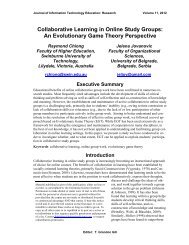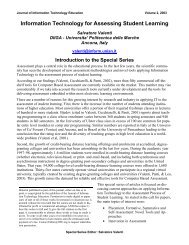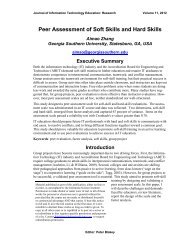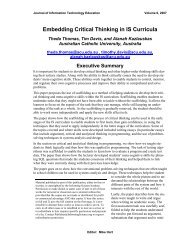Does Math Achievement h'APP'en when iPads and Game-Based ...
Does Math Achievement h'APP'en when iPads and Game-Based ...
Does Math Achievement h'APP'en when iPads and Game-Based ...
You also want an ePaper? Increase the reach of your titles
YUMPU automatically turns print PDFs into web optimized ePapers that Google loves.
The Impact of <strong>iPads</strong> on <strong>Math</strong> <strong>Achievement</strong><br />
tent. An intentional focus on mathematics in the elementary years would be necessary to ensure<br />
students’ foundational mathematics underst<strong>and</strong>ing <strong>and</strong> to increase students’ mathematics<br />
achievement (Ozel, Yetkiner & Capraro, 2008; Sarama & Clements, 2009).<br />
Researchers have encouraged the integration of technology in the mathematics classroom (Amin,<br />
2010; Banister, 2010; Moreau, 2010; Ross, Morrison, & Lowther, 2010). Officials in many<br />
school districts have invested in student technology because research has indicated that technology<br />
could be used to promote students’ learning, engagement, <strong>and</strong> mathematics achievement<br />
(Bell, 2007; Castelluccio, 2010; Cuban, 2001; DeCastro-Ambrosetti & Cho, 2002; Stevens, 2011;<br />
Suki, Suki, Eshaq, & Choo, 2010; Todd, 2010; Traxler, 2010). The iPad is one of the most recent<br />
technology devices introduced into classrooms. The iPad has specialized applications in which<br />
multiple senses (e.g., auditory, visual, <strong>and</strong> tactile) are incorporated; the use of multiple sensory<br />
inputs has been shown to reinforce student learning <strong>and</strong> to achieve a variety of mathematics objectives<br />
(Castelluccio, 2010; Hill, 2011; Murphy, 2011; Price, 2011; Stevens, 2011). Interactive<br />
game-based learning <strong>and</strong> wireless Internet access with the iPad could become tools with which<br />
educators revamp the current learning environment (Hill, 2011). Scholarly research on the effects<br />
of iPad use on education has been limited in general <strong>and</strong> nonexistent for mathematics achievement<br />
since the device became available in 2010, specifically within the elementary setting (Hlodan,<br />
2010). The thorough investigation of the effects of <strong>iPads</strong> on fifth-grade mathematics<br />
achievement could not only fill a gap in the existing literature but also be used to inform elementary<br />
mathematics teachers.<br />
The purpose of the current quantitative, quasi-experimental study was to examine the impact of<br />
the iPad’s use as a 1:1 computing device on fifth-grade students’ mathematics achievement in two<br />
rural Virginia elementary schools. Both schools were located within Samuel Douglas County<br />
(pseudonym used) school district, located in the western region of Virginia. As based on a power<br />
analysis, a group of 48 fifth-grade student participants from one elementary school <strong>and</strong> 56 fifthgrade<br />
student participants from a second elementary school of similar demographic characteristics<br />
completed the same Scott Foresman-Addison Wesley (SFAW) fifth-grade mathematics Virginia<br />
st<strong>and</strong>ards of learning (SOL) aligned assessment pretest. For one academic quarter, the participating<br />
teacher <strong>and</strong> fifth-grade mathematics students in the experimental group used the <strong>iPads</strong><br />
as 1:1 computing devices for at least one mathematics activity daily during math class. These<br />
iPad activities included, but were not limited to, playing game-based learning applications, reviewing<br />
presentations, accessing online video tutorials, or using interactive manipulatives. The<br />
participating teacher <strong>and</strong> students in the control group did not use <strong>iPads</strong> as 1:1 computing devices<br />
daily during the mathematics class. Non-iPad activities included, but were not limited to, playing<br />
collaborative learning games, completing worksheets <strong>and</strong> projects, or using physical manipulatives.<br />
After the academic quarter, all participating fifth-grade students completed the same SFAW<br />
fifth-grade mathematics Virginia SOL aligned assessment posttest. The iPad intervention effects<br />
were measured according to the mean difference between the two groups from the pretest to the<br />
posttest.<br />
Limited research exists regarding the potential use of the iPad in the elementary mathematics<br />
classroom (Hlodan, 2010). Data were provided regarding what relationship, if any, existed between<br />
student mathematics achievement <strong>and</strong> iPad use in classrooms. School administrators <strong>and</strong><br />
other academic directors could use the results to make informed decisions about purchasing technology<br />
<strong>and</strong> using <strong>iPads</strong> for mathematics instruction.<br />
Theoretical Framework<br />
The theoretical foundation for the study was the experimental theory developed by the American<br />
philosopher, John Dewey. Dewey (1922) wanted to gain a better underst<strong>and</strong>ing of how <strong>and</strong> why<br />
students learned. He concluded that learners gained knowledge through their individual experi-<br />
270










